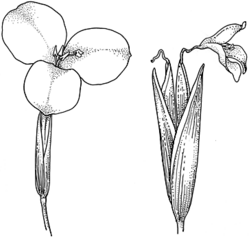
Description: Perennial herbs, mostly evergreen; rhizome woody, rarely corm-like.
Leaves basal or cauline, equitant, usually linear or sword-shaped. Scapes erect, terete, unbranched, but often clasped at base by innermost leaf; inflorescence capitate, enclosed by a pair of large, rigid spathe bracts enclosing 2 groups of 1–6 sessile flowers.
Flowers actinomorphic; fragile, short-lived, opening in succession on sunny days. Perianth tube filiform; outer tepals broad, spreading; inner tepals very small, erect. Stamens exserted from perianth tube; filaments ± fused. Style filiform, entire; stigma 3-lobed or almost fully fused.
Capsule cylindrical, trigonous, sessile; seeds numerous.
Distribution and occurrence: World: 20 species, Australia & Malesia, New Caledonia. Australia: 18 species (endemic), Qld, Vic., Tas., S.A.
Text by T. A. James & E. A. Brown (1993); edited KL Wilson (May 2016); edited RW Jobson (2023)
Taxon concept:
| | Key to the species | |
| 1 | Leaves, flowering stems and spathes glabrous; seeds compressed-ovoid, black, smooth, 2–2.5 mm long with a prominent white aril confined to one end | Patersonia fragilis |
| Leaves, flowering stems or spathes at least party hairy when young, sometimes glabrescent with age; seeds cylindrical, cylindrical-fusiform to narrowly ovoid, brown, sometimes with a waxy bloom, finely and closely longitudinally striate to ridged, mostly 2.5–6 mm long, aril lacking or if present then linear and on one side of the seed for virtually the whole length of the seed, with or without a larger cap-like part at one end | 2 |
| 2 | Leaves cauline; flowering stems (above leaves) glabrous; seeds arillate | Patersonia glabrata |
| Leaves all basal; flowering stems (above leaves) pubescent, at least partly; seeds with or without an aril
Back to 1 | 3 |
| 3 | Spathes greyish-brown to mid-brown; seeds arillate, lacking a pit at one end | Patersonia rosea |
| Spathes dark brown to blackish; seeds lacking an aril, with a prominent pit at one end
Back to 2 | Patersonia sericea |
|


